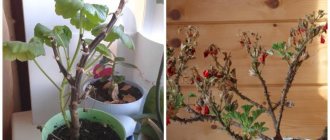So, the most harmless situation is when the leaves of a purchased rose dry out and fall off. Everything is clear here; this bush is going through a period of acclimatization. In flower shops he had completely different conditions: the air was not so dry, and they were stuffed with fertilizer for abundant flowering to the delight of customers.
In the first few weeks, the flower will adapt to its new place of residence and may even partially shed its leaves. You don’t need to do anything with it, just put the pot in a bright place and water it periodically. After some time, the bush will get used to it and repair itself.
A purchased rose must be trimmed immediately after bringing it home, shortening the branches to 5 buds.
More serious reasons for roses drying out may be:
- errors in care;
- presence of pests;
- disease.
Why does an indoor flower in a pot disappear?
The most common causes of death of indoor roses include:
- lack of moisture (perceived especially painfully when there is a lack of microelements and humus in the soil);
- high lime content in the soil;
- excess moisture in the soil (often due to improper drainage or lack thereof);
- lack of sunlight;
- diseases (such as cancer or rust);
- pests (for example, insect larvae).
How to properly care for a flower to prevent drying
To prevent your indoor rose from drying out, you need to provide it with proper care.
- The indoor rose is one of the light-loving plants, so the best place to place it is the windowsill of a window facing south.
- If this is not possible, she will have to provide additional illumination using a phytolamp.
- The air temperature in the room should be maintained at 18-25 degrees.
- To ensure full development in the warm season, it is advisable to take the pot with the plant out into the fresh air (in a secluded corner of the garden or on the balcony).
- The room where the rose pot is located must be regularly ventilated, avoiding drafts in every possible way.
- To water an indoor rose, you must use tap water at room temperature, standing for 24 hours. Knowing that the flower does not like lime, some gardeners water it with boiled water.
- A plant that cannot tolerate dry air must be sprayed daily, if possible doing this in the evening.
- You can revive a capricious plant with regular (at least twice a month) fertilizing with complex mineral fertilizers.
- Experienced flower growers recommend using Bona Forte liquid complex fertilizer to feed home roses, watering the flower with a solution of this drug once a week, and the next week using the same solution to spray the leaves. Throughout the growing season, such watering and spraying must be alternated.
- Once a week it is necessary to treat the roses with a solution of the Fitoverm insecticide.
- To form a beautiful bush, the plant needs periodic pruning, which consists of removing dry inflorescences and twigs, as well as shoots that have grown over the winter and disrupt the correct shape of the crown. It is best to perform them in the spring months.
When can a plant not be saved?
If the flower has completely dried out, or the vast majority of its roots have rotted, no resuscitation will help it. The prognosis is also disappointing if the plant is entirely affected by mold or pests. In these situations, it is necessary to dig up and dispose of the affected plant to prevent infection and death of neighboring plants.
If measures to resuscitate the flower do not have an effect, you need to carefully dig up or pull the plant out of the pot and inspect its roots. If the roots are severely damaged by pests or rot, a final measure can help - pruning all old and affected shoots from the bush, which will facilitate its restoration. It is pointless to cut off dead roots, since it is impossible to restore them .
Why do rose leaves dry out?
Why do hydrangea leaves dry at the edges?
Most often, the rose dries out and sheds its leaves as a result of the negative effects of diseases. The most harmful among them are the following:
- Powdery and downy mildew (peronospora) mildew. The main symptom is a whitish coating. The edges of the foliage of a diseased plant begin to dry out and then fall off. Affected plantings are treated with copper-based preparations. For prevention, roses are sprayed with Bordeaux mixture from time to time. Downy mildew usually appears in the form of dark marks affecting young foliage. Mature leaves become covered with lightish spots, which outwardly resemble signs of powdery mildew. As the disease progresses, the spots become purple and the leaves dry out. To save the plant, substances containing copper and zinc are used, and prevention involves the application of phosphorus-potassium fertilizers during the potential period of damage.
Powdery mildew on roses - Rust. The entire plant becomes covered with dark marks, after which individual parts of the bushes begin to dry out, which leads to its withering. The disease is treated by spraying with copper and zinc preparations. With the onset of spring, the area should be cleared of frozen and broken plants.
- Gray rot. Affected specimens become covered with a characteristic mold-like coating. In a short time, the bushes dry out and the rose dies. Damaged particles are cut off, and the plantings are treated with foundation.
- Pestalocia charred. This fungal disease affects the shoots, but as a result of their death, the leaf inevitably dries out. The diseased parts of the bush are cut off and burned, and the roses are sprayed with foundationazole.
- Infectious burn. The disease affects the stems, forming brown marks on them. Subsequently, the leaves begin to dry out. The affected parts of the roses are cut out and then sprayed with a fungicide. Healthy plants are sprayed with Bordeaux mixture.
The rose dries and sheds its leaves and is attacked by pests. So, this is most typical for spider mites. Also, the answer to the question of why the rose withers and dries may be the influence of insects such as:
- leaf beetles;
- thrips;
- goldfish;
- rose aphid;
- nematodes;
- sawfly.
Sawfly pest of roses
The grower is required to constantly monitor the plantings and respond to symptoms of the presence of pests. It is necessary to use only clean and disinfected soil (this is especially true for the sand ingredient).
When asked why the leaves of garden roses dry out, one should also answer that when cultivated in open ground, roses are often affected by small animals such as mice and moles. They interfere with the normal feeding process of roses, which leads to a number of negative consequences for the plant, including the fact that the rose withers in the garden.
What to do to prevent recurrence of problems?
In order to prevent disease or death of roses, it is necessary to follow certain preventive measures. First of all, do not neglect compliance with the rules of agricultural technology. If the plant is affected by mold or pests, proper care will help reduce damage to the flower.
In flower shops, plants in pots are fertilized with special fertilizers that maintain their beautiful marketable appearance. Also, in the room where flowers are displayed, acceptable air humidity is constantly maintained. Therefore, getting from the favorable conditions of a flower shop to less favorable apartment conditions, an indoor rose may become less attractive, fade or get sick (what should be the care of a rose after purchasing it in a store?).
It is recommended not to allow negligence in care , even if the plant is in full health. Moreover, caring for an indoor rose is simple and does not require much time. Regularly pay attention to your plants and respond to symptoms of illness in a timely manner.
By following these simple tips and recommendations, you can help your indoor roses and extend their life. With proper care and sensitivity, this plant can delight you with its magnificent flowers for a long time.
General rules for caring for roses in the garden
When planting roses in open ground, the following should be considered:
Selecting a seat
Why do rose buds dry out without blooming?
The place for the garden rose should be well lit. When planting several bushes at once, you should place them so that low plants are in the foreground, and taller plants are moved back to avoid shading. In shady conditions, garden roses grow much worse, they practically do not bloom, and dark spots form on the leaves.
On a note! To avoid the development and spread of fungal diseases (primarily powdery mildew), the plantings should be provided with a sufficient level of air circulation; however, a strong draft is no less dangerous for roses.
The soil on which roses will be cultivated must first be well loosened. The soil must be saturated with nutrients, and the depth of the fertile layer must be at least 40 cm. Wetlands are absolutely not suitable for plants. Plots with close groundwater should be avoided.
Preparing the soil for planting
The most effective way to prepare a site for planting roses is also the longest. In this case, they use old newspapers, which are laid out on the surface of the plot in 8-12 layers and fixed with something so that they do not fly away. The plot is left in this state for 2 months. During this period, all weeds will die under such cover, and the soil will soften greatly and will be easier to dig up.
Planting roses
After this, you need to determine the acidity of the soil. The optimal pH level for roses varies from 6 to 7. If the soil is acidic, the situation is corrected by adding lime.
Next, dig a planting hole into which fertilizer is added. If superphosphate is used, you need to make sure that the drug does not come into direct contact with the roots of the rose. The substance is placed in the hole, covered with soil, and only after that the plant is placed there. In most cases, a drainage system is formed in the hole, for which large crushed stone, branches, and expanded clay are used.
Note! It is also recommended to pour 250 g of bone meal into the hole.
Landing
If roses are planted in the spring, you need to wait until the soil is warm enough after thawing. In most regions of Russia, the optimal period for planting roses begins in the last ten days of April and lasts until mid-May. You shouldn’t delay planting either. At the end of spring, the soil is already heating up quite strongly, and it will be difficult for the plant to take root and grow normally in such conditions. Even after taking root, the plant will be weak in such conditions outside and will begin to shed its leaves and buds.
It is also possible to plant in the autumn. To do this, select the period from the second ten days of September to the second ten days of October. At this time, the weather is relatively warm, the soil has not yet had time to cool and contains a significant amount of moisture. At the same time, in regions where autumn is rarely warm and long (in Siberia), planting dates are moved to the end of August-September.
To plant or replant a plant in the fall, you need to prepare the planting hole a month and a half before the procedure. In any case, at least 20-30 days must pass after planting and before the first frost begins.
For your information! The size of the hole should be sufficient for the plants to feel free. On fertile soils, a hole depth of half a meter and the same width is sufficient. In clayey areas, the width remains the same, but the depth increases to 60-70 cm.
When the hole is ready, pour water into it and wait until the liquid is completely absorbed. After this, plants with a closed root system are placed directly into the hole. If roses have open roots, then their tips are shortened by a third, and then placed in a solution of water or a root formation stimulator for several hours.
A low earthen mound is formed in the center of the hole. The plant is placed on it, and the roots are spread throughout the hole. In this case, the root collar should be located at least 5 cm below the surface of the hole. Then the hole is covered with earth. For convenience, a shallow side is dug in the bite sector, which will prevent water from spreading.
Important! Upon completion of planting, the plants should be watered well.
The rosette reacts negatively to crowded plantings and can be affected by diseases and shed leaves in such conditions. Therefore, the flower needs to be provided with sufficient spatial isolation. Depending on the specific species, this figure ranges from 50 cm to 1 m. However, this distance may vary depending on the purposes of plant cultivation. Thus, bush roses also look great as single planted plants, while in rose gardens the above distance between two plants is maintained.
Subsequent care for planting indoor or outdoor roses involves the following procedures:
- irrigation;
- feeding;
- trimmings;
- pest and disease control;
- transplantation if necessary;
- reproduction, etc.
Lack of light is the cause of yellow leaves on a rose
A rose growing on a north window will suffer from a lack of lighting, which will affect its appearance. The leaves will begin to turn pale and yellow, the plant will not bloom.
Roses need good lighting. In winter they are placed in the brightest windows, and in summer they can be grown on balconies or in the garden. In spring and summer, when the sun is active, do not forget to shade the plant. In winter, in a room with insufficient light, additional lighting with phytolamps or fluorescent lamps may be needed.
Attention! Rose leaves may turn yellow due to sunburn. Therefore, when choosing a place for flowers, be careful. In the garden or on the balcony, place a pot with a plant in light partial shade.
Lack of lighting or moisture
The rose loves well-lit places, and when planting a bush in a dark corner of the site, it will not have enough sunlight not only for normal development, but also for flowering. Therefore, the plant begins to shed leaves and buds.
At the same time, it is not recommended to plant roses in an area that is exposed to the sun all day, as this will lead to a similar problem. It is better to give preference to a flower bed that is well lit in the first half of the day - this way there will be enough light, and the leaves and buds will not burn in the scorching midday sun.
Drying of buds and leaves may be the first sign of lack of moisture, especially if you miss regular watering in the hot summer. Conversely, if there are signs of rot on the shoots, the cause is rotting of the root system as a result of waterlogging and stagnation of moisture.
It is important to choose the right place to plant a rose and water it regularly so that the flower has enough strength to grow leaves and bloom.
Diseases and pests
Various diseases and pests can undoubtedly lead to dry leaves on roses in the garden.
The condition of the bush can be affected by the following diseases:
The cause of infection is often a new infected bush, or even untreated garden tools (yes, even when working with plants, tools require sterility!). To avoid diseases, prevention must be carried out. This is a mandatory spring treatment of the plant and the soil around it with special products.
New bushes can be soaked in a fungicide solution to avoid infections and fungi, if any.
Also, rose leaves and young shoots may wither if there are pests.
Pests
- Rose leafhopper. Small insects are yellow. They are often the reason why roses wither without blooming.
- Spider mite. They can be seen on the inside of the leaf in the form of white balls. They also leave small cobwebs in the buds and on the stem.
May beetle larvae. Failure to promptly identify and get rid of this pest can lead to the rapid death of the rose.
You can get rid of the above pests using special insecticidal agents.
Remember that before you determine what to do with the plant, you need to understand why the leaves of a garden rose dry out. After all, the wrong help can aggravate an existing problem.
Effect of weather conditions
Sometimes all your care efforts can be ruined by unfavorable weather conditions. The leaves of the rose dry out due to too frequent rains. Indeed, in connection with this, the soil becomes waterlogged, water washes away nutrients and the plant suffers.
Temperature changes can also cause spoiled shoots. For example, after heavy rain, the bright sun does not have as good an effect on the flower as we would like. The sun begins to warm up the drops that remain on the plant, and at the same time the rays burn the leaves.
Too hot weather also leads to deterioration of the plant. It is impossible to somehow influence the weather and change it. But a good way out of this situation would be to plant in a convenient place - where the gardener can have maximum control over external factors from watering to lighting.
Improper watering
Often, beginning gardeners try very hard to care for their plants and water their roses almost every day. Frequent waterlogging of the soil leads to rotting of the roots, yellowing of the leaves and even death of the flower. Plants need to be watered only after the top layer of soil has dried to a depth of one centimeter (if the rosette is small), and to a depth of 2-3 cm if the plant grows in a large pot.
However, overdrying the soil is no better than waterlogging. Do not let the soil in the pot dry out completely and crack. This will also be the cause of yellow, dry and falling leaves.
- If, due to waterlogging of the soil, the foliage turns yellow, falls off, and the roots rot, the rose needs an urgent transplant with a change of soil. During transplantation, rotten roots are cut off and sprinkled with crushed activated carbon. The flower is transplanted into new soil and watered as needed.
- Dry soil cannot be completely moistened by watering. The rose pot should be placed in a bowl of water for half an hour so that the soil is completely saturated.










